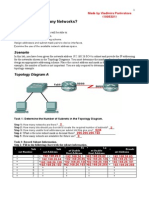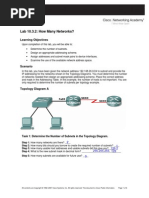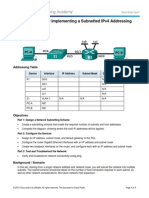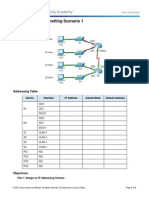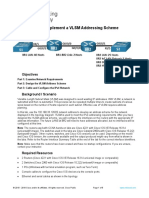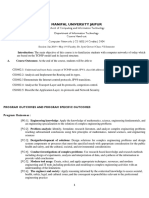Objectives: Step 1: Determine The Number of Subnets in Network Topology A
Objectives: Step 1: Determine The Number of Subnets in Network Topology A
Uploaded by
Mohamed HellmYCopyright:
Available Formats
Objectives: Step 1: Determine The Number of Subnets in Network Topology A
Objectives: Step 1: Determine The Number of Subnets in Network Topology A
Uploaded by
Mohamed HellmYOriginal Description:
Original Title
Copyright
Available Formats
Share this document
Did you find this document useful?
Is this content inappropriate?
Copyright:
Available Formats
Objectives: Step 1: Determine The Number of Subnets in Network Topology A
Objectives: Step 1: Determine The Number of Subnets in Network Topology A
Uploaded by
Mohamed HellmYCopyright:
Available Formats
Objectives
Parts 1 to 5, for each network topology:
Determine the number of subnets.
Design an appropriate addressing scheme.
Assign addresses and subnet mask pairs to device interfaces.
Examine the use of the available network address space and future growth potential.
Background / Scenario
When given a network topology, it is important to be able to determine the number of subnets
required. In this lab, several scenario topologies will be provided, along with a base network address
and mask. You will subnet the network address and provide an IP addressing scheme that will
accommodate the number of subnets displayed in the topology diagram. You must determine the
number of bits to borrow, the number of hosts per subnet, and potential for growth as specified by the
instructions.
Part 1: Network Topology A
In Part 1, you have been given the 192.168.10.0/24 network address to subnet, with the following
topology. Determine the number of networks needed and then design an appropriate addressing
scheme.
Step 1: Determine the number of subnets in Network Topology A.
a. How many subnets are there? ___________
b. How many bits should you borrow to create the required number of subnets? _________
c. How many usable host addresses per subnet are in this addressing scheme? ___________
d. What is the new subnet mask in dotted decimal format? _________________________
e. How many subnets are available for future use? _______________
Step 2: Record the subnet information.
Fill in the following table with the subnet information:
Subnet Subnet First Usable Host Last Usable Host Broadcast
Number Address Address Address Address
0
1
2
3
4
5
Part 2: Network Topology B
The network topology from Part 1 has expanded to accommodate the addition of router R3 and its
accompanying network, as illustrated in the following topology. Use the 192.168.10.0/24 network
address to provide addresses to the network devices, and then design a new addressing scheme to
support the additional network requirement.
Step 1: Determine the number of subnets in Network Topology B.
a. How many subnets are there? ___________
b. How many bits should you borrow to create the required number of subnets? _________
c. How many usable host addresses per subnet are in this addressing scheme? ___________
d. What is the new subnet mask in dotted decimal format? _________________________
e. How many subnets are available for future use? _______________
Step 2: Record the subnet information.
Fill in the following table with the subnet information:
Subnet Subnet First Usable Host Last Usable Host Broadcast
Number Address Address Address Address
0
1
2
3
4
5
6
7
Part 3: Network Topology C
The topology has changed again with a new LAN added to R2 and a redundant link between R1 and
R3. Use the 192.168.10.0/24 network address to provide addresses to the network devices. Also
provide an IP address scheme that will accommodate these additional devices. For this topology,
assign a subnet to each network.
Step 1: Determine the number of subnets in Network Topology C.
a. How many subnets are there? ___________
b. How many bits should you borrow to create the required number of subnets? _________
c. How many usable host addresses per subnet are in this addressing scheme? ___________
d. What is the new subnet mask in dotted decimal format? _________________________
e. How many subnets are available for future use? _______________
Step 2: Record the subnet information.
Fill in the following table with the subnet information:
Subnet Subnet First Usable Host Last Usable Host Broadcast
Number Address Address Address Address
0
1
2
3
4
5
6
7
8
9
10
You might also like
- Kavita BSNL ReportDocument29 pagesKavita BSNL Reportmdbsbilal987No ratings yet
- 9.1.4.9 Lab - Subnetting Network TopologiesDocument9 pages9.1.4.9 Lab - Subnetting Network Topologiesjdotbakes84% (32)
- Lab 10 - 3 - 2 PDFDocument5 pagesLab 10 - 3 - 2 PDFaref12345No ratings yet
- Lab 4.1.5 Sub Netting A NetworkDocument5 pagesLab 4.1.5 Sub Netting A Networkonlycisco.tkNo ratings yet
- Lab - Activity CCNA 2 Exp: 3.5.4Document3 pagesLab - Activity CCNA 2 Exp: 3.5.4Rico Agung FirmansyahNo ratings yet
- Indoor Radio Planning: A Practical Guide for 2G, 3G and 4GFrom EverandIndoor Radio Planning: A Practical Guide for 2G, 3G and 4GRating: 5 out of 5 stars5/5 (1)
- Exploring BeagleBone: Tools and Techniques for Building with Embedded LinuxFrom EverandExploring BeagleBone: Tools and Techniques for Building with Embedded LinuxRating: 4 out of 5 stars4/5 (1)
- Packet Tracer - Basic Switch Configuration - Physical Mode: TopologyDocument8 pagesPacket Tracer - Basic Switch Configuration - Physical Mode: TopologyThira BeibeiNo ratings yet
- Subnetting Network TopologiesDocument9 pagesSubnetting Network TopologiesDeley18No ratings yet
- 10 3 2 2Document6 pages10 3 2 2Justin MasonNo ratings yet
- 9.1.4.9 Lab - Subnetting Network TopologiesDocument9 pages9.1.4.9 Lab - Subnetting Network TopologiesdojolcNo ratings yet
- Lab 10.3.2: How Many Networks?: Learning ObjectivesDocument6 pagesLab 10.3.2: How Many Networks?: Learning ObjectivesmajksnerNo ratings yet
- IPv4 Address Subnetting Part 2Document2 pagesIPv4 Address Subnetting Part 2mueller_gbNo ratings yet
- Classfull Subnettinsubnettungg HomeworkDocument4 pagesClassfull Subnettinsubnettungg HomeworkNoel SanchezNo ratings yet
- Subnetting Network TopologiesDocument9 pagesSubnetting Network Topologies22520678No ratings yet
- Lab 9.3.3 Designing An IP Subnetting Scheme For Growth: ObjectivesDocument4 pagesLab 9.3.3 Designing An IP Subnetting Scheme For Growth: ObjectivessugapriyaNo ratings yet
- Lab 1035b Subneting Class ADocument1 pageLab 1035b Subneting Class AruletriplexNo ratings yet
- Subnetting Network Topology NAME: - COMPUTER NUMBERDocument3 pagesSubnetting Network Topology NAME: - COMPUTER NUMBERAkende MumaNo ratings yet
- 9.2.1.3+lab+ +Designing+and+Implementing+a+Subnetted+Ipv4+Addressing+SchemeDocument7 pages9.2.1.3+lab+ +Designing+and+Implementing+a+Subnetted+Ipv4+Addressing+Schemejmbad789No ratings yet
- 9.1.4.9 Lab - Subnetting Network TopologiesDocument11 pages9.1.4.9 Lab - Subnetting Network TopologiesEdgar RamirezNo ratings yet
- 8.2.1.5 Lab - Designing and Implementing A VLSM Addressing Scheme - ILM2Document1 page8.2.1.5 Lab - Designing and Implementing A VLSM Addressing Scheme - ILM2Kealeboga Elliott KealebogaNo ratings yet
- Lab 10.3.5b Subnetting A Class A Network: ObjectiveDocument1 pageLab 10.3.5b Subnetting A Class A Network: ObjectiveHamzaSpahijaNo ratings yet
- E2 Lab 3 5 4Document3 pagesE2 Lab 3 5 4Ninja NuggetNo ratings yet
- Lab 4.1.5 - Subnetting A NetworkDocument5 pagesLab 4.1.5 - Subnetting A NetworkUltraPrinceNo ratings yet
- 4 - Challenging - VLSM IP AddressingDocument11 pages4 - Challenging - VLSM IP AddressingnujugtrNo ratings yet
- Name:: Computer Networks IDocument6 pagesName:: Computer Networks IikejimenesNo ratings yet
- On Tap NWC203c Fall2022Document9 pagesOn Tap NWC203c Fall2022PjRNo ratings yet
- Lab 1Document4 pagesLab 1Suranga LakmalNo ratings yet
- E2 Act 6 4 2Document11 pagesE2 Act 6 4 2Fabian GomezNo ratings yet
- SubnettingDocument18 pagesSubnettingOpeyemi OsanaiyeNo ratings yet
- VLSM SubnettingDocument6 pagesVLSM SubnettingLajos HomorNo ratings yet
- TP SubnettingDocument3 pagesTP Subnettingwail.sefritiNo ratings yet
- lab-VLSM-Sessional2 Lab Task PDFDocument4 pageslab-VLSM-Sessional2 Lab Task PDFmuhammad ahmad hayatNo ratings yet
- Lab 11.5.4: Network Testing: Topology DiagramDocument7 pagesLab 11.5.4: Network Testing: Topology DiagramNhựt LưuNo ratings yet
- 9.2.1.3 Lab - Designing and Implementing A Subnetted IPv4 Addressing SchemeDocument7 pages9.2.1.3 Lab - Designing and Implementing A Subnetted IPv4 Addressing Schemeamimul137480% (2)
- Lab 2 - VLSMDocument7 pagesLab 2 - VLSMwachelokNo ratings yet
- Subnetting Network Topologies TaskDocument7 pagesSubnetting Network Topologies Taskmarkcleocalbang05No ratings yet
- Modul 8 Ipv4 Subnetting: Lab - Designing and Implementing A Subnetted Ipv4 Addressing SchemeDocument10 pagesModul 8 Ipv4 Subnetting: Lab - Designing and Implementing A Subnetted Ipv4 Addressing SchemeNico TpgNo ratings yet
- Basic 4Document11 pagesBasic 4skinss246No ratings yet
- 9.1.4.6 Packet Tracer - Subnetting Scenario 1 InstructionsDocument4 pages9.1.4.6 Packet Tracer - Subnetting Scenario 1 InstructionsRadu Florin TriponNo ratings yet
- Final Quiz - 34Document8 pagesFinal Quiz - 34رافد البركي100% (1)
- E2 Act 6 4 3Document5 pagesE2 Act 6 4 3Fabian GomezNo ratings yet
- Lab2.4 - Design and Implement A VLSM Addressing SchemeDocument5 pagesLab2.4 - Design and Implement A VLSM Addressing SchemelilianaNo ratings yet
- Radio Frequency Identification and Sensors: From RFID to Chipless RFIDFrom EverandRadio Frequency Identification and Sensors: From RFID to Chipless RFIDNo ratings yet
- Backhauling / Fronthauling for Future Wireless SystemsFrom EverandBackhauling / Fronthauling for Future Wireless SystemsKazi Mohammed Saidul HuqNo ratings yet
- C Programming for the Pc the Mac and the Arduino Microcontroller SystemFrom EverandC Programming for the Pc the Mac and the Arduino Microcontroller SystemNo ratings yet
- Keras to Kubernetes: The Journey of a Machine Learning Model to ProductionFrom EverandKeras to Kubernetes: The Journey of a Machine Learning Model to ProductionNo ratings yet
- Integration of Demand Response into the Electricity Chain: Challenges, Opportunities, and Smart Grid SolutionsFrom EverandIntegration of Demand Response into the Electricity Chain: Challenges, Opportunities, and Smart Grid SolutionsNo ratings yet
- Multidisciplinary Design Optimization Supported by Knowledge Based EngineeringFrom EverandMultidisciplinary Design Optimization Supported by Knowledge Based EngineeringNo ratings yet
- CompTIA Network+ CertMike: Prepare. Practice. Pass the Test! Get Certified!: Exam N10-008From EverandCompTIA Network+ CertMike: Prepare. Practice. Pass the Test! Get Certified!: Exam N10-008No ratings yet
- Architecture-Aware Optimization Strategies in Real-time Image ProcessingFrom EverandArchitecture-Aware Optimization Strategies in Real-time Image ProcessingNo ratings yet
- Electronic Structure Calculations on Graphics Processing Units: From Quantum Chemistry to Condensed Matter PhysicsFrom EverandElectronic Structure Calculations on Graphics Processing Units: From Quantum Chemistry to Condensed Matter PhysicsRoss C. WalkerNo ratings yet
- TCP IP TutorialDocument48 pagesTCP IP TutorialDzintars Podziņš100% (1)
- E Thio InternshipDocument37 pagesE Thio InternshipYared100% (1)
- IPv4 Subnetting Scenario 1Document4 pagesIPv4 Subnetting Scenario 1mehrdad arabiNo ratings yet
- IMS-ZXUN CG-BC-EN-Installation and Commissioning-Software Installation Guide-1-201011-BOOK-115Document115 pagesIMS-ZXUN CG-BC-EN-Installation and Commissioning-Software Installation Guide-1-201011-BOOK-115BSSNo ratings yet
- Asst I Part BDocument3 pagesAsst I Part BfaizuNo ratings yet
- Comset CM685 User Manual - Rev 5 3 Dec 2013Document117 pagesComset CM685 User Manual - Rev 5 3 Dec 2013Mr KhanNo ratings yet
- CCNA BOOTCAMP - ActivityDocument41 pagesCCNA BOOTCAMP - ActivityEric ResuelloNo ratings yet
- Network Configuration Tool: Operation ManualDocument77 pagesNetwork Configuration Tool: Operation ManualKhaled El-RayesNo ratings yet
- Accu Mark V 10 Network SecurityDocument18 pagesAccu Mark V 10 Network SecurityEmil LoghinNo ratings yet
- Modbus For Dedicated Controls: Functional Profile and User ManualDocument92 pagesModbus For Dedicated Controls: Functional Profile and User ManualPhillip TomcatNo ratings yet
- CCNA 200-125 V3.0 2018.4.17 Chinese DumpDocument164 pagesCCNA 200-125 V3.0 2018.4.17 Chinese DumpAmine BoubakeurNo ratings yet
- 4 1 IP Addressing Lyst7910Document104 pages4 1 IP Addressing Lyst7910rohan singhNo ratings yet
- G1701 InstallationDocument128 pagesG1701 InstallationEllen DawitriNo ratings yet
- Course Handout-Computer Networks - CS1602Document9 pagesCourse Handout-Computer Networks - CS1602none nadaNo ratings yet
- Site Recovery Manager and Policy Based DR: Deep Dive With EngineeringDocument35 pagesSite Recovery Manager and Policy Based DR: Deep Dive With EngineeringRaghuveer TalekarNo ratings yet
- Syntax.: T Iming Refers To Two Characteristics: When Data Should Be Sent and How Fast It Can Be SentDocument130 pagesSyntax.: T Iming Refers To Two Characteristics: When Data Should Be Sent and How Fast It Can Be SentVarghese ShibuNo ratings yet
- Lab 04 - Implement Virtual NetworkingDocument8 pagesLab 04 - Implement Virtual NetworkingMoussa YasbahNo ratings yet
- Hcia - Routing and Switching Mock ExamDocument187 pagesHcia - Routing and Switching Mock ExamAbdelmoumen Achache78% (9)
- EIGRPDocument6 pagesEIGRPjayanandjaiNo ratings yet
- CP R80.10 and Above Virtual Machine Scale Sets (VMSS) For Microsoft AzureDocument52 pagesCP R80.10 and Above Virtual Machine Scale Sets (VMSS) For Microsoft Azuresimoo2010No ratings yet
- 08 - IP SubnettingDocument20 pages08 - IP Subnettingkndnew guadeNo ratings yet
- Iot Hardware: Raspberry Pi 3 Model BDocument39 pagesIot Hardware: Raspberry Pi 3 Model BbbmathiNo ratings yet
- Teste Cisco 640-822Document241 pagesTeste Cisco 640-822kappa_gNo ratings yet
- x930 Ds RevzcDocument8 pagesx930 Ds RevzcRomi JasmanNo ratings yet
- 2 - Spadvroute 1.0 - Lab GuideDocument132 pages2 - Spadvroute 1.0 - Lab GuideannajugaNo ratings yet
- En FMBT-21 Um B A4Document92 pagesEn FMBT-21 Um B A4Sami DaoudNo ratings yet
- Modbus Protocol UGDocument33 pagesModbus Protocol UGMuhammad Sa'ad100% (1)
- Implementing Cisco IP Routing (Version 6.0) - Answers - 2011 - 2012Document13 pagesImplementing Cisco IP Routing (Version 6.0) - Answers - 2011 - 2012Nishan Maflax100% (1)


